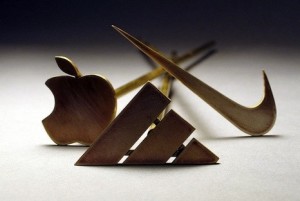 When you see the famous “swoosh” logo on running shoes, on sportswear, on a top player’s tennis bandana, or on a football boot then you know instinctively that it is Nike and it is very likely that the Nike brand conjures up in your mind many positive thoughts and feelings. People feel that when they wear Nike and sport the famous swoosh their chances of success are increased.
When you see the famous “swoosh” logo on running shoes, on sportswear, on a top player’s tennis bandana, or on a football boot then you know instinctively that it is Nike and it is very likely that the Nike brand conjures up in your mind many positive thoughts and feelings. People feel that when they wear Nike and sport the famous swoosh their chances of success are increased.
It may be difficult to believe, but that swoosh logo was created in 1971 by a graphic design student for a firm called Blue Ribbon Sports that was marketing football a new football boot called Nike. It is by the way that she was paid a meagre $35 for it, but it went on to be one of the more recognisable logos in the world. Although there have been subtle design changes in order to incorporate in the actual fabric of items of sportswear, and it originally appeared with the name Nike until it became a stand-alone image in 1995, it is one of the most consistent logos you are likely to come across. Does Nike have any plans to change it? You bet they don’t.
What exactly is a brand?
There have been many thousands of attempts to define exactly what a brand really is. You can view it as something external, an artefact that includes a name, a sign, a logo, a design, or any combination of these, that is used to identify a product or organisation and which differentiates it from the rest of the crowd. Alternatively you can view it as the impact that this combination has on the thoughts and the emotions of the customer; an internalisation of the corporate image that the external branding attempts to convey. When you wear the Nike swoosh it’s because you want to be a winner.
Brand consistency
Just consider the impact should Nike decide that their swoosh logo was getting a little old and tired and needed changing. We don’t mean a few adjustments round the edges; many companies have done that including Nike. For instance the Pepsi Cola logo has slowly evolved over the years and the Starbucks logo has progressively become more minimalist as has Apple’s apple; however they have all retained the essence of their corporate branding.
If Nike was to abandon the swoosh logo and replace it with something entirely different then it is likely that the vast majority of Nike customers would feel let down and betrayed. Many of them would feel angry and that anger would result in them walking away and ceasing to purchase their sportswear from the company. Rebranding can be accomplished with very careful management but it is difficult to accomplish successfully; for instance when Everton attempted to introduce a revised logo there was an outcry and a 20,000 signature petition; Gap received severe derision form its customers when it tried to change its logo and had to revert to the old one; the chances are that if Nike lost the swoosh the company would struggle to survive.
Sometimes it might be necessary to change a brand, but in the words of the old adage “If it ain’t broke, don’t fix it”.
A consistent brand engenders customer loyalty and makes your business and everything it does instantly recognisable. It provides your business with a real personality that your customers relate to emotionally. When you use a consistent brand your message is reinforced across the whole range of your products and services. It provides authority and trust in your business.
In a nutshell…
In a nutshell, being consistent means being recognised. Consistent branding breeds familiarity, trust and confidence. If your customers are to be confident in you then you need to be confident in yourself, and that confidence is demonstrated by being consistent in your branding.












Recent Comments